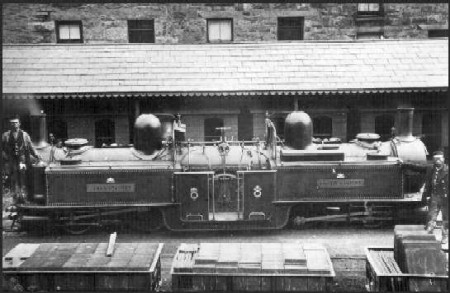|
CGR 1st Class 4-4-0
The Cape Government Railways 1st Class 4-4-0 of 1879 was a South African steam locomotive from the pre-Union era in the Cape of Good Hope. In 1878, the Cape Government Railways placed orders with the Avonside Engine Company for four more 1st Class tender locomotives with a 4-4-0 American type wheel arrangement. They were intended for fast passenger service on the Western and Eastern Systems and were delivered in 1879. In 1880, eleven more of these locomotives followed from Neilson and Company.''C.G.R. Numbering Revised'', Article by Dave Littley, SA Rail May–June 1993, pp. 94-95. Traffic growth By 1878, increased traffic on the Western System of the Cape Government Railways (CGR) had given rise to a requirement for higher train speeds, which subjected most of the existing mainline locomotives with their small diameter coupled wheels to rapid wear and resulted in the need for frequent heavy repairs. To meet the rising traffic requirements, orders were placed with Avonside Eng ... [...More Info...] [...Related Items...] OR: [Wikipedia] [Google] [Baidu] |
Avonside Engine Company
The Avonside Engine Company was a locomotive manufacturer in Avon Street, St Philip's Marsh, St. Philip's, Bristol, England between 1864 and 1934. However the business originated with an earlier enterprise Henry Stothert and Company. Origins The firm was originally started by Henry Stothert in 1837 as Henry Stothert and Company. Henry was the son of George Stothert (senior), founder of the nearby Bath, Somerset, Bath engineering firm of Stothert & Pitt. Henry's brother, also named George, was manager of the same firm. The company was given an order for two broad gauge () GWR Firefly Class, Firefly class express passenger engines ''Arrow'' and ''Dart'', with driving wheels, delivered for the opening of the Great Western Railway (GWR) from Bristol to Bath, Somerset, Bath on 31 August 1840. This was soon followed by an order for eight smaller GWR Sun Class, Sun class engines with driving wheels. Stothert, Slaughter and Company Edward Slaughter joined the company in 1841, when i ... [...More Info...] [...Related Items...] OR: [Wikipedia] [Google] [Baidu] |
King William's Town
Qonce, formerly known as King William's Town, is a city in the Eastern Cape province of South Africa along the banks of the Buffalo River. The city is about northwest of the Indian Ocean port of East London. Qonce, with a population of around 35,000 inhabitants, forms part of the Buffalo City Metropolitan Municipality. Qonce lies above sea level at the foot of the Amathole Mountains in an area known for its agriculture. The city has one of the oldest post offices in the country developed by missionaries led by Charles Brownlee. History For thousands of years, the area was roamed by Bushman bands, and then was used as grazing by the nomadic Khoikhoi, who called the Buffalo River ''Qonce''. Xhosa people first settled in the area during the mid- to late- 17th century. King William's Town was founded by Sir Benjamin d’Urban in May 1835 during the Xhosa War of that year. The town stands on the site of the kraal of the minor chief Dyani Tyatyu and was named after Wil ... [...More Info...] [...Related Items...] OR: [Wikipedia] [Google] [Baidu] |
Railway Locomotives Introduced In 1879
Rail transport (also known as train transport) is a means of transport that transfers passengers and goods on wheeled vehicles running on rails, which are incorporated in tracks. In contrast to road transport, where the vehicles run on a prepared flat surface, rail vehicles ( rolling stock) are directionally guided by the tracks on which they run. Tracks usually consist of steel rails, installed on sleepers (ties) set in ballast, on which the rolling stock, usually fitted with metal wheels, moves. Other variations are also possible, such as "slab track", in which the rails are fastened to a concrete foundation resting on a prepared subsurface. Rolling stock in a rail transport system generally encounters lower frictional resistance than rubber-tyred road vehicles, so passenger and freight cars (carriages and wagons) can be coupled into longer trains. The operation is carried out by a railway company, providing transport between train stations or freight customer ... [...More Info...] [...Related Items...] OR: [Wikipedia] [Google] [Baidu] |
Cape Gauge Railway Locomotives
A cape is a clothing accessory or a sleeveless outer garment which drapes the wearer's back, arms, and chest, and connects at the neck. History Capes were common in medieval Europe, especially when combined with a hood in the chaperon. They have had periodic returns to fashion - for example, in nineteenth-century Europe. Roman Catholic clergy wear a type of cape known as a ferraiolo, which is worn for formal events outside a ritualistic context. The cope is a liturgical vestment in the form of a cape. Capes are often highly decorated with elaborate embroidery. Capes remain in regular use as rainwear in various military units and police forces, in France for example. A gas cape was a voluminous military garment designed to give rain protection to someone wearing the bulky gas masks used in twentieth-century wars. Rich noblemen and elite warriors of the Aztec Empire would wear a tilmàtli; a Mesoamerican cloak/cape used as a symbol of their upper status. Cloth and clothin ... [...More Info...] [...Related Items...] OR: [Wikipedia] [Google] [Baidu] |
Neilson Locomotives
Neilson may refer to: Places * Zec Batiscan-Neilson, in the Portneuf Regional County Municipality, Quebec, Canada * Neilson Township, in Portneuf Regional County Municipality, Quebec, Canada * Neilson River (Bras du Nord), Saint-Raymond, Portneuf Regional County Municipality, Quebec, Canada Business * Neilson Dairy, or William Neilson Dairy Limited, a Canadian dairy company * Neilson and Company, 19th century locomotive manufacturer in Glasgow, Scotland Other uses * Neilson (name), people with the given name or surname * Roger Neilson Memorial Award, annual award for the top academic College/University player in the Ontario Hockey League See also * Nielsen (other) * Neilston, a village and parish in East Renfrewshire in the west central Lowlands of Scotland {{disambig ... [...More Info...] [...Related Items...] OR: [Wikipedia] [Google] [Baidu] |
Avonside Locomotives
Avonside is an eastern suburb in Christchurch, New Zealand. It is one of the oldest suburbs of the city, with only Heathcote being older. History The suburb was named after Holy Trinity Avonside, which was built beside the Avon River in 1855. The 1874 part of the church was designed by the eminent architect Benjamin Mountfort who is buried in the churchyard. The church was damaged in the 2010 Canterbury earthquake and whilst under repair, was damaged beyond repair in the February 2011 Christchurch earthquake and demolished later that year. Avonside is home to Avonside Girls' High School. It also has the Avon River flowing through it. The boundaries of the original Anglican parish of Avonside were fixed in 1859 and covered much of what is now suburbs such as Aranui, Burwood, Linwood, Marshland, New Brighton, North New Brighton, Parklands and part of Phillipstown. The area once covered the whole of north east Christchurch as far as the River Styx. The area borders the ... [...More Info...] [...Related Items...] OR: [Wikipedia] [Google] [Baidu] |
CGR Locomotives
{{disambig ...
CGR may refer to: * Campo Grande International Airport (IATA airport code) * Canadian Government Railways * Cape Government Railways * Center for Governmental Research * Ceylon Government Railway * Chip Ganassi Racing * Classic Game Room * Commercial gramophone record – see Spelling of disc * Condensate to Gas Ratio * Contraloría General de la República de Costa Rica * Cyprus Government Railway The Cyprus Government Railway was a narrow gauge railway network that operated in Cyprus from October 1905 to December 1951. With a total length of , there were 39 stations, stops and halts, the most prominent of which served Famagusta, Prasti ... [...More Info...] [...Related Items...] OR: [Wikipedia] [Google] [Baidu] |
Central South African Railways
The Central South African Railways (CSAR) was from 1902 to 1910 the operator of public railways in the Transvaal Colony and Orange River Colony in what is now South Africa. During the Anglo-Boer War, as British forces moved into the territory of the Orange Free State and the South African Republic, the Orange Free State Government Railways, the Netherlands-South African Railway Company and the Pretoria-Pietersburg Railway were taken over by the Imperial Military Railways under Lieutenant-Colonel Sir Percy Girouard. After the war had ended, the Imperial Military Railways became the Central South African Railways in July 1902, with Thomas Rees Price as general manager. With the creation of the Union of South Africa in 1910, the CSAR was merged with the Cape Government Railways and the Natal Government Railways to form the South African Railways, which is now Transnet Freight Rail. References Further reading * Defunct railway companies of South Africa Railway companies estab ... [...More Info...] [...Related Items...] OR: [Wikipedia] [Google] [Baidu] |
Natal Government Railways
The Natal Government Railways (NGR) was formed in January 1877 in the Colony of Natal. In 1877, the Natal Government Railways acquired the Natal Railway Company for the sum of £40,000, gaining the line from the Point to Durban and from Durban to Umgeni. This move, inspired in part by the neighbouring Cape Prime Minister John Molteno's 1873 establishment of the Cape Government Railways, was intended to drive the extension of Natal's railways inland, towards the Drakensberg and eventually the Orange Free State. The Natal Government Railways also adopted the Cape gauge. The core line went from Durban to Volksrust, but reached Charlestown ( from the border of the South African Republic) in 1891 and was linked to the Witwatersrand in 1895. Other important lines were the one linking with the Orange Free State reaching Harrismith in 1892, as well as the North Coast and South Coast lines. In 1910, the Union of South Africa was formed and in 1912 the NGR combined with the other colo ... [...More Info...] [...Related Items...] OR: [Wikipedia] [Google] [Baidu] |
Beaufort West
Beaufort West (Afrikaans: ''Beaufort-Wes''; Xhosa: ''eBhofolo'') is a town in the Western Cape province in South Africa. It is the largest town in the arid Great Karoo region, and is known as the "Capital of the Karoo". It forms part of the Beaufort West Local Municipality, with 34,085 inhabitants in 2011. It is the centre of an agricultural district based mainly on sheep farming, and is a significant town and logistical support hub on the N1 national road. Next door to Beaufort West is the Karoo National Park. Important Permian era fossils have been found in the area to the west of the town. Initially found by David Baird, son of the local magistrate in 1827. The old Town Hall and the Dutch Reformed Church have been declared national monuments. History Beaufort West was the first town to be established in the central Karoo. The town was founded in 1818 and initially named ''Beaufort'' after Henry Somerset, 5th Duke of Beaufort, who was the father of Lord Charles Henry Som ... [...More Info...] [...Related Items...] OR: [Wikipedia] [Google] [Baidu] |
_1879_no._35.jpg)


